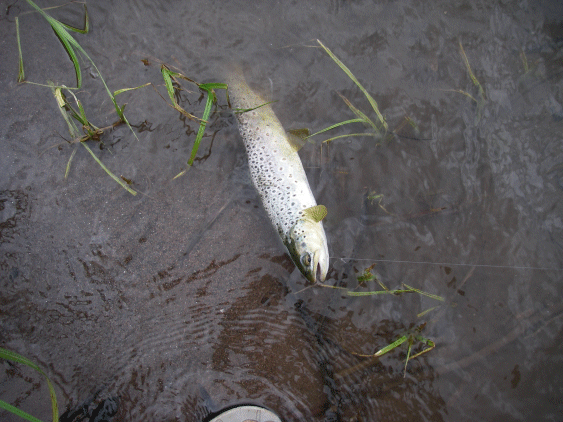 And the fish
cooperated. Rigged up with a #16 RL WRS trailed by a # 18 antenna
pupa. Despite the discolored water most of the (slob) browns came to the
surface fly.
And the fish
cooperated. Rigged up with a #16 RL WRS trailed by a # 18 antenna
pupa. Despite the discolored water most of the (slob) browns came to the
surface fly. July, 2005
07/01: The holiday crowds are upon us, but having a slight case of cabin fever and needing to get out of the condo, I took my first tentative steps on a our local river, most of which are slowly but surely recovering from runoff. Today it was off to the middle Colorado in the neighborhood of State Bridge. We really never have shoreside casting competition on this stretch, but today the middle of the river was packed with relentless hordes of river runners, rafts, drift boats, kayaks, and inner tubes.
Happily those folks didn't invade my casting space, so the experience wasn't nearly as bad as it could have been. The river is still a bit on the high side and probably somewhat more colored than it will be in the next couple of weeks. Thunderstorms didn't help much either, but it was still fun being back on the water.
 And the fish
cooperated. Rigged up with a #16 RL WRS trailed by a # 18 antenna
pupa. Despite the discolored water most of the (slob) browns came to the
surface fly.
And the fish
cooperated. Rigged up with a #16 RL WRS trailed by a # 18 antenna
pupa. Despite the discolored water most of the (slob) browns came to the
surface fly.
A couple of sub foot long rainbows also took the WRS in the mouth of the Piney River.
In the hour & a half I was working the mostly pocket water, I would guess playing a good dozen and a half fish. With the exception of those rainbows everything else was a brown under fourteen inches.
It still was fun being on the water locally.
Late next week after the crowds have gone home, we'll try to get over to the Crystal, Roaring Fork, and maybe the lower Gunnison as well.
7/6-7: Sue's tied up this week with relatives and other things, so I'm off to enjoy the green drake hatch on the Roaring Fork, some nymphing on the Crystal, and terrestrials plus flat water caddis on the lower Gunnison. At least that's what the script reads.
Got an early start and arrived in Glenwood Springs around 2:00 in the afternoon. Too early for green drakes. Bought food for the trip, loaded up the ice box, and parked behind Safeway to do the walk down to the streamside park behind that building to a nice stretch of the Roaring Fork..
That river is still running high but clear. Pretty tough wading. Not too many bugs in the air, though as the afternoon progressed, the yellow sally hatch persisted and got stronger all the way through early evening. I rigged with a rubber legged WRS trailed by a #18 antenna pupa. Not much interest on the part of anything so changed out the pupa for a hair wing sally. Things got better almost immediately in a riffle and released a sixteen inch hen brown.
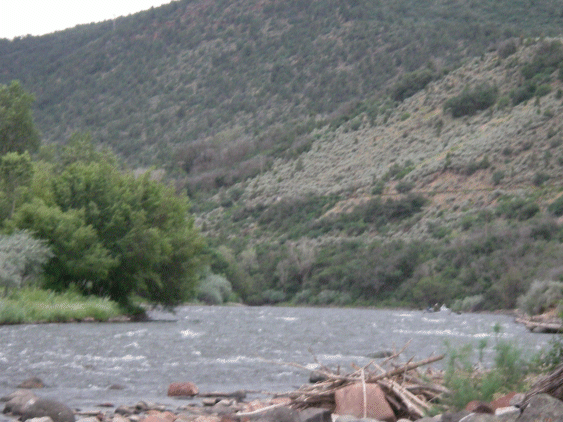 This part of the river
is way too deep for dry fly fishing given the present flows so I drove to the
Sunlight Bridge and walked down river left for a quarter mile intending to try
the flats in this area.
This part of the river
is way too deep for dry fly fishing given the present flows so I drove to the
Sunlight Bridge and walked down river left for a quarter mile intending to try
the flats in this area.
Lots of drift boats coming through. It almost looked like the traffic on the Green if one can imagine that level of activity on the water.
Action wasn't great. Changed the hair winged sally to a flat water variety and started getting a few more strikes.
Speaking of strikes, the most striking thing I encountered was the large number of small (second and third year browns) along the banks and behind rocks mid stream. On the Green, these juveniles would have been inhaled by their larger cousins immediately, but on this river, they apparently are safe from that type of predation.
I walked the shore water for a good half mile and kept getting strikes from these tiny (5-8 inch) fish. Not a lot of fun. Eventually did release a couple of fourteen inchers - all browns - but it was not great fishing.
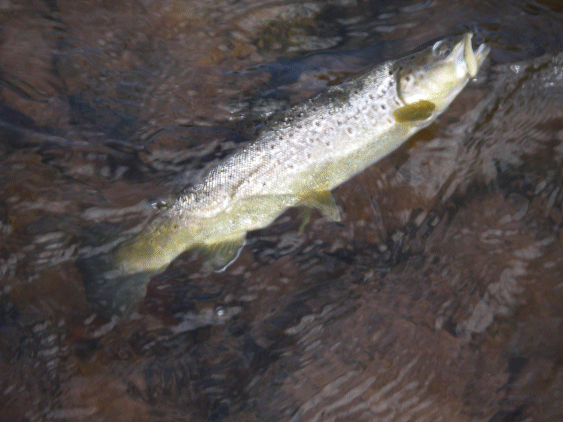 Up the river we drove
to the stretch above the airport. Things got worse almost
immediately. A heavy thunderstorm dropped rain for a couple of
hours.
Up the river we drove
to the stretch above the airport. Things got worse almost
immediately. A heavy thunderstorm dropped rain for a couple of
hours.
I shouldn't say things got worse. The fishing actually got better, but the drake hatch never materialized.
Caught and released good numbers of mixed browns and rainbows in the ten-fourteen inch range, but the weather was awful.
Swirling and gusty thunderstorm winds. Driving rain. Just ugly. The stream slowly turned chocolate brown, I suspect, due to mud being washed into the Crystal.
Eventually I gave up the ghost just before nightfall. Considered doing the drive to the Gunnison over McClure Pass and rejected that thought, so drove upstream to Basalt and turned up the Frying Pan. Went way upstream, did a turnoff that was a new one, and miraculously found a "street legal" camping place where I'd no idea one existed. Great views as the sun disappeared and a wonderful quiet night of sleep.
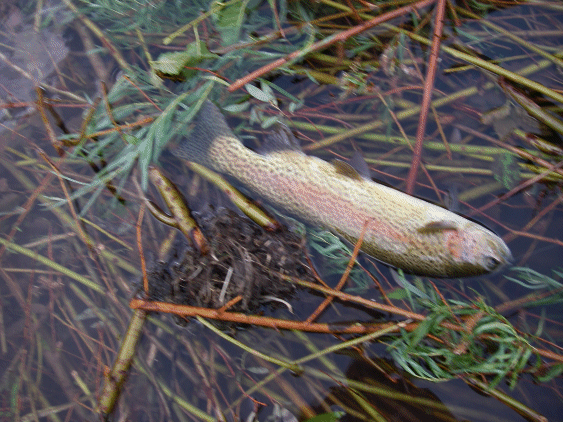 Coffee at 7:00 the
next morning followed by some interesting exploration of a section of this
stream that I not only "hate to love", but also "love to
hate".
Coffee at 7:00 the
next morning followed by some interesting exploration of a section of this
stream that I not only "hate to love", but also "love to
hate".
The location of a strange looking fishing spot that I came upon cannot be described here as to the exact location of these fish, but suffice it to say, by 8:15, I had released a good dozen mixed rainbows and browns between 14-20 inches.
Most hit a smallish soft hackle caddis and a few came to the #18 WRS on top.
Not bad results for a river I really don't have much appreciation for. Maybe that's now changed.
Drove a bit further downstream from the dam and gave the rough pocket water a good try for a quarter mile or so. Results were not good at all. Even changing to a double nymph rig of tiny larva and RS-2 brought only one fourteen inch brown to hand.
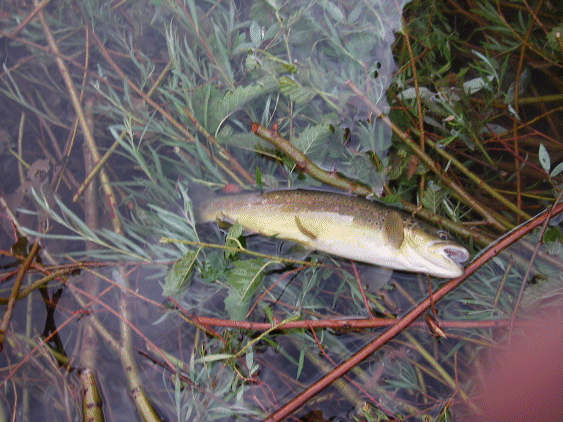 Back up by the dam on
some tight shoreline water that's really only reachable by left handed casting,
things picked up immediately.
Back up by the dam on
some tight shoreline water that's really only reachable by left handed casting,
things picked up immediately.
The brown drake hatch that had been apparent in the lower pocket water was still ongoing up here, and a #20 tan bodied comparadun seemed to match that fly very closely.
It was sight casting to sipping browns and rainbows, and virtually every fish the fly drifted over at least took a swipe at it.
Although missing numbers of lightning quick strikes, I would guess releasing another 12-15 fish in a short period of time.
Sizes were decent in the twelve to sixteen inch range and the species were evenly distributed between rainbows and browns.
Hit a couple more places on the lower river - between the 4 and 6 mile
markers and continued very nice success everywhere. A PMD hatch had also
started, and the combination of a #18 comparadun of that insect followed by a
spent wing (loop wing) brown  mayfly
really took fish from every holding area.
mayfly
really took fish from every holding area.
The lower river fish are far more feisty when hooked compared to their more lethargic cousins up by the dam.
Those upper water trout know exactly what's happening when they're hooked and make very little effort to escape - identical situation to tailwaters everywhere.
Mid afternoon I decided to trot on over to the Crystal to see if it had cleared and might be fishable.
As I crossed the stream on the outskirts of Carbondale, it was clear the river was not.
More thunderstorms began shortly, and I gave up the fight. It would have been nice to spend another day on the water, but with uncooperative weather, it made more sense to head back to the barn and try again next week.
7/11: A need to do some shopping in Frisco - over the pass - gave Sue & I the opportunity to get in an hour or so of fishing on a nice little stream called Ten Mile Creek. That water's best flows are between Copper Mountain and Lake Dillon, but since the creek parallels the freeway (I-70) people are intimidated about pulling off the busy highway, parking, rigging up, and trying that nice looking water. We do not share those kinds of issues, and do fish this stretch a good deal of the time when in the area.
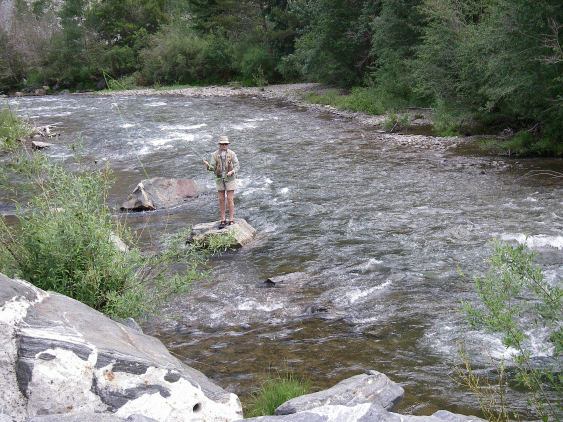 With this week's
strong thunderstorms, the creek was clear but much higher than we'd hoped it
would be.
With this week's
strong thunderstorms, the creek was clear but much higher than we'd hoped it
would be.
Crossing it would have been possible, but not advisable. So we alternated casting to pools and holding areas as best we could.
As we'd both rigged up with a surface fly and trailing bead head, hopefully we had the bases all covered though each of us had different results.
I started with a #16 rubber legged WRS on the surface and a #18 copper john trailing. Sue began with a standard WRS and a larger bead head behind.
My results were better earlier as the relatively unsophisticated fish in this stream were more drawn to the attractor fly. No fish were large - the best being a twelve inch brown. I probably released a good dozen fish on our two stops along the highway - all but one brookie were browns. Sue's releases were all rainbows - go figure.
Tomorrow I head off for two or three days - somewhere. Most likely it will be Rocky Mountain Park and the Colorado and some of its tributaries below the park.
7/12-13:
With Sue tied up on some work projects, my fishing options this week were limited to either testing the waters around Rocky Mountain Park or making the first foray on to our favorite stream in Northwest Colorado. The latter won out despite knowledge that at the roughly 600 c.f.s. it was running, wading would be a chore at best.
Arrived in late morning and was astonished to see a massive earth moving project in progress just across the river. At almost a full mile in length, that much dirt being bermed and shoved all over what had been quite pristine horse pasture land was disappointing to say the least. It really looked like an eighteen hole golf course being constructed. I later found out that the property owner had approval to place sixty five "cabins" on the land.
So much for what has been in my opinion - the finest piece of publicly accessible trout water in Colorado - if not in the country. Apparently there are no more last great places. I suspect we'll have 3-5 more years of quality fishing here, and that will be the end of it for all time.
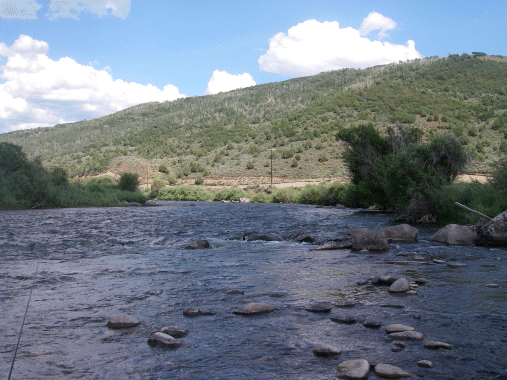 Rigged up and did
the difficult wade across the stream and the mile hike down to our regular
starting point at the trough hole.
Rigged up and did
the difficult wade across the stream and the mile hike down to our regular
starting point at the trough hole.
The positive thing about higher flows is that it allows the fish to spread out further and not have to crowd into the center of deeper holes or sit in the shallower, but better aerated riffle water.
Wonderful fishing it continues to be. Hatches were modest. Lots of midges and a few smaller tan bodied caddis over the water - more of them in the bushes.
A couple of yellow sallies and strangely a few blue winged olives, but the fish seemed focused on the caddis issue. Rigged with a # 18 rubber legged WRS and trailed it with a #18 antenna pupa.
Strikes were good right off the bat. Most came to the surface fly which I alternated with a standard (non rubber leg) WRS all day long.
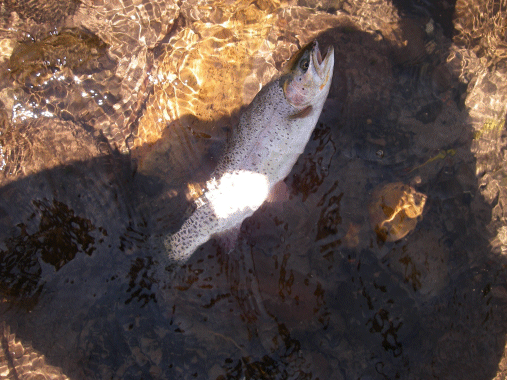 The nymph took its
usual number of whiteys and several of that species also came to the dry -
happily not too many.
The nymph took its
usual number of whiteys and several of that species also came to the dry -
happily not too many.
My first release was a beautiful chubby sixteen inch cutthroat. Very pretty fish. I love cuts. Ended up missing lots of strikes this day.
Also played and "long released" numbers of mixed rainbows and cutthroats. The fish are very strong and wild here.
Once in a while you'll encounter a "tailwater" type of mouth, but for the most part, these trout act as though this was their first time being hooked. Just terrific action.
Sizes were outstanding as always.
While my releases only were up to eighteen inches, clearly some of the hogs I played were well into the 20's. There were several fish a good two feet in length that I didn't even try to coax to the fly.
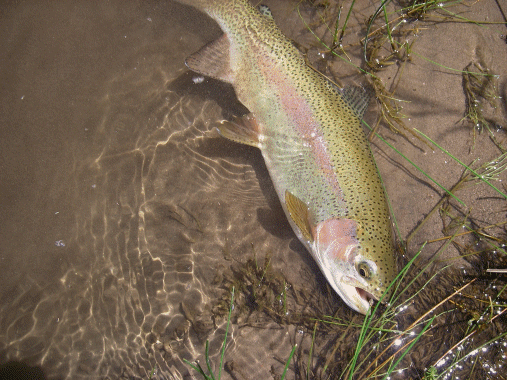 Those were located
in seams or runs where it would have been impossible for me to either run with
them during the fight - or in some other way - be able to land and release
them.
Those were located
in seams or runs where it would have been impossible for me to either run with
them during the fight - or in some other way - be able to land and release
them.
Truly outstanding amazing fishing, and it's been this way for as long as we've fished here.
After dinner a bit upstream, I spent some time on the "catch and eat" section of the river. Smaller sizes and fewer fish as might be expected.
Next morning I saddled up early and headed to the campground at the start of the trail up the South Fork canyon. The intent was to fish the south in the morning and then try the north in the afternoon which is what I did. The south canyon trail is visually outstanding throughout its length. Just beautiful vistas wherever one looks.
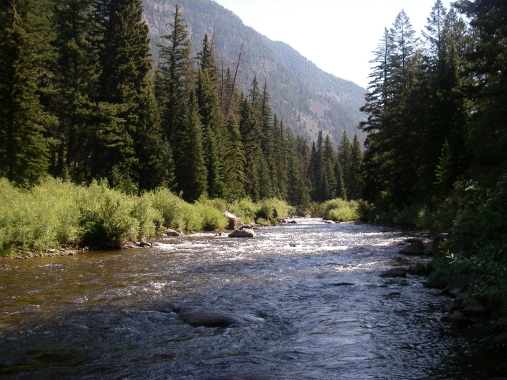
While it's possible to actually wade the stream all the way up from the trailhead, with water as high as it is currently, that task would be very difficult and quite treacherous in places.
Also I noticed that the south fork was quite a bit colder than the north or the main stem which I suspect may have had an effect on the quality of the fishing there - at least this day.
Compared to the other local branch and the main river, the hatches here were astonishing in their intensity and diversity. A massive emergence of large brown drakes preceded the midges. Caddis were flitting everywhere and yellow sallies also filled the air. On any other stream fish would have broken the surface in earnest and would have done that all day long. Here the fish were mostly silent - or simply had too much underwater sustenance for them to have to come to the surface.
Unhappily at this time of year, the south is also populated by hordes of hungry deer flies. Even lathering up with 100% deet did nothing to discourage those nasty bugs. At times during the day my legs looked like red zebra stripes from the blood running down where they'd done their biting.
Yes, I know waders would have prevented the problem, but I'd no interest at all in donning even good Gore-Tex waders on the 2-3 mile hike uphill that I did this morning followed of course by the return trip. The heat generated by waders would have been far more unpleasant to cope with than were the bug bites.
OK. The fishing for me was not great. I know a lot of folks who hike and cast this stream all the time and really love it. But from my perspective, the present higher flows prevent easy access to some of the better holding areas. It may also be the case that like the Crystal, this stream simply doesn't fish well early in the day. As noted above, few fish ever came to a surface fly, and it seemed impossible to get strikes without truly dredging the bottom.
Probably released a dozen or so trout in the morning - equally split between bows and cuts. Sizes were modest in the six to twelve inch range. I'll remember to not return here until the flows are lower.
Did a bit of pocket water casting in the stream just above the parking area and had somewhat better success there. Still it wasn't up to previous year's results. Frankly I just don't think this fork is as productive as its alternative to the north.
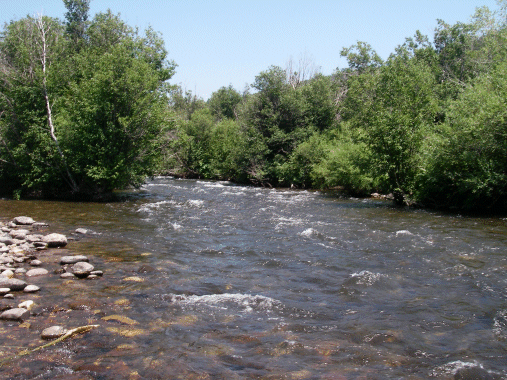
Which I drove up to after grabbing a quick lunch at the parking lot.
The plan was to try three or four previously fished spots on the north fork. As it turned out, it only took one stop to make the day. It's an odd little section of USFS water sandwiched between some private properties, and honestly, I don't think it gets fished much at all.
At least the trout behave that way.
The first eddy next to a riffle gave up a half dozen nice cutthroat including one double hookup.
Upstream from there, virtually any water that should have held a trout did so. In the space of maybe an hour I'd guess releasing a good two dozen fish, mostly cutthroats with a smattering of rainbows. Modest sizes up to fourteen inches, but lots of fun and continuous action.
So it seemed to be a waste of time to drive further up into the Forest Service water several miles, which led me back down to the main stem and the bottom part of our normal wade. It was late afternoon and the sun was baking the water unlike the prior day when thunderclouds were present all day long.
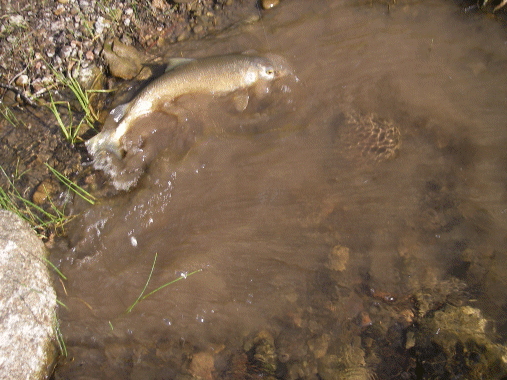
The first few spots I tried were pretty unaccommodating, so I shifted to a double nymph rig and had a bit better success, though most of these were whitefish.
Eventually I was irresistibly drawn back to the trough hole and was pleasantly surprised to see heads coming up all over the pool to what were pretty likely caddis flitting on the water.
A change to a #16 tan bodied WRS and its trailing neighbor, a #16 antenna pupa, did some good, but not what I'd hoped for.
Even though most of the water in this pool is pretty rough, the impressionistic WRS was just not "realistic" enough for the better trout.
So instead of the pupa I tried alternating couple of flat water caddis. One is tied with some of the newer translucent winging material and the other with a wing constructed of folded turkey feather. Interestingly the latter won the day even though to my eye, the plastic material is more realistic looking. Apparently at least the fish know best.
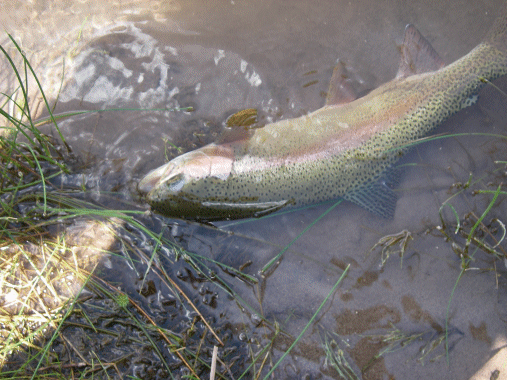
It ended up being an outstanding finish to what had been a very long ten hour day of continuous hiking and casting.
Lots of big rainbows released and even more missed. At that point "too much of a good thing......." kicked in and I chose to head back to Vail instead of spending the following morning on the same water.
Next week we're off to Frontier Days which means some casting on the Poudre for sure and probably more of the same on the North Platte.
7/19-22:
Hi Ho Silver. Away! The initial focus of this week's trip to southern Wyoming was supposed to be for a day at the famous Frontier Days rodeo in Cheyenne.
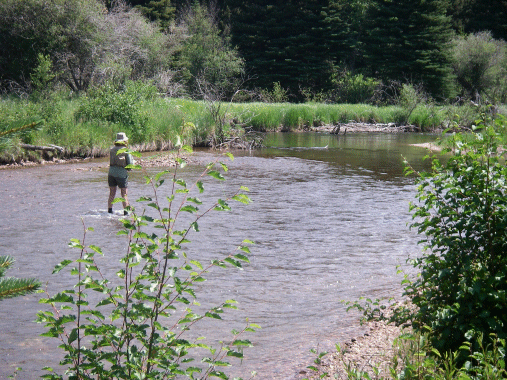 As has always been
the case, we are able to get in a bit of fishing on the Poudre as we head north,
and we were able to fish that river again this year. The stream was
running slightly high, although also very clear when we arrived at the first
place we normally access the river high up in the mountains.
As has always been
the case, we are able to get in a bit of fishing on the Poudre as we head north,
and we were able to fish that river again this year. The stream was
running slightly high, although also very clear when we arrived at the first
place we normally access the river high up in the mountains.
It's a fairly placid meandering stretch of freestone water with some interesting runs and a few shallow pools and generally holds a decent population of the local browns. This year it was pretty consistent in that regard even if the overall fish sizes seemed a bit shorter than what we've previously experienced .
Some odd hatches were going on in the early afternoon hours that had me a bit baffled.
Midges of course were in the shoreside eddies, but some unusual mayfly drakes (at least in my experience) were in the air. I couldn't catch any to get a closer peek at their species, but some looked like green drakes and others like red quills - neither of which should have been coming off at this early time of day. A few caddis were also about though they were mostly resting in the bushes.
In an attempt to cover both bases I rigged up with a #18 flat water caddis and a #16 tan bodied WRS at the far end. Surprisingly the only thing that took a fish was the caddis. It surely didn't look like any of the mayflies that seemed to be dominant, but it really was the only effective pattern this afternoon.
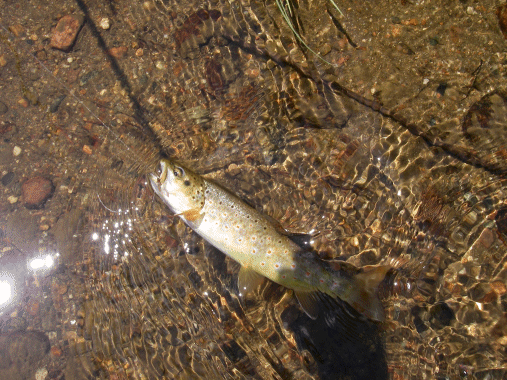 Pretty much every
decent looking riffle, pool, or run gave up a fish or two, but we cut this wade
short when thunderstorms began to erupt just to the east of us.
Pretty much every
decent looking riffle, pool, or run gave up a fish or two, but we cut this wade
short when thunderstorms began to erupt just to the east of us.
That rain ruled out our next planned stop and delayed our getting on the flat water section below the hatchery. Even though we never do particularly well on that difficult technical water, it's always fun to test, as it does contain quite a few much better sized fish than other parts of this river.
Nothing came to the surface so I finally switched the trailing fly to a #20 RS-2 nymph, fished it with a small split shot, and eventually released but one twelve inch brown. At that point the rains came harder & I ran back to the van to avoid a good soaking.
More lousy weather followed us down river. We tried one more spot at a rest area below Rustic and caught a handful more browns on the surface, but it really wasn't much fun given the miserably rainy day. Camped that night in the mountains on a side dirt road between the Poudre and Red Feather Lakes and got an early start to Cheyenne the next morning.
Arrived in that small city heading first towards the Sierra Outlet store which is in our opinion a must stop whenever passing through Cheyenne and we were both surprised by the lack of billboards announcing what was going on at Frontier Days. Guess what? We were a week early. Sue was nonplussed, and I was amused - the rodeo not being my favorite way to spend a very hot July afternoon in the Wyoming sun.
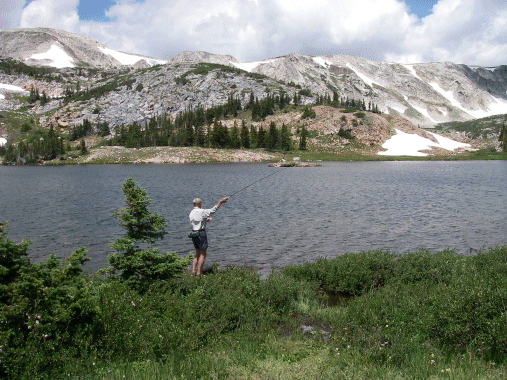 We recovered.
Visited the outlet store and Sue made a small purchase. Tried to decide
what to do next and more or less came up empty handed - or empty minded - which
would be more appropriate.
We recovered.
Visited the outlet store and Sue made a small purchase. Tried to decide
what to do next and more or less came up empty handed - or empty minded - which
would be more appropriate.
Knew we were going to go west to Laramie, so set off on the freeway in that direction. Had planned an overnight camp out on the top of Happy Jack road, but as it was still mid morning, chose instead to continue through Laramie and do the scenic drive over the Snowies.
It's a pleasant and pretty drive. Got up high at the lakes area and tried casting to a couple of them. No results though I did see a trout follow my wooly bugger for several feet.
On the way down the pass we turned off on a forest road that would take us over and around all the French Creek tributaries which we'd also never visited. It was a haul doing this road, but eventually we crossed all the forks and then passed down the main stem of this creek, never finding anything that looked like decent trout holding water. We can take this creek off our list of eligible opportunities.
At the end of French Creek, the road to Bennett Peak reared itself and we drove to that camping/fishing access area of the North Platte. Another mistake. The river's low and very mossy - also very warm. We waded downstream a half mile from Corral Creek and spent a good deal of time trying all kinds of approaches to what usually are decent numbers of nicely sized rainbows in some swift riffle water. Nothing at all today. Very disappointing.
Rather than waste another night and day here, we packed up again and drove out of the area through Riverside and Encampment and eventually made our way into the Hog Park area where we camped for the night. A really long and relentlessly disappointing day from a fishing standpoint. It was a reaaaaallllly long day.
Ah. Things finally get better the next morning. We had some recommendations regarding the upper Encampment River - which we followed to the tee the following day.
This was a tough hike and wade. Actually the wading and bushwhacking back up were much more difficult than the hike downstream into the wilderness area. It was worth it. We'll come back here again. I suspect not many others will try this. We went five miles (at least) down the trail. Then we fished and mushed our way back up maybe two miles (that took a good four hours) before giving up and crossing back to the trail and heading exhausted back to the car.
In all honesty the fishing was great. It's all brown trout water again. These browns are wild fish. In no way do they resemble their cousins in the tailwaters or in other parts of Wyoming or Colorado. They strike hard, leap with abandon, and fight to the bitter end - almost as if they don't know that we simply going to gently extract the fly from their mouths. I caught one small rainbow for the only other trout type of the trip. Sue played a whitefish.
It was a lot of fun. OK. Most of the fish were not large. Some were. We've heard stories of 22-24 inch browns in some of the deeper holes.
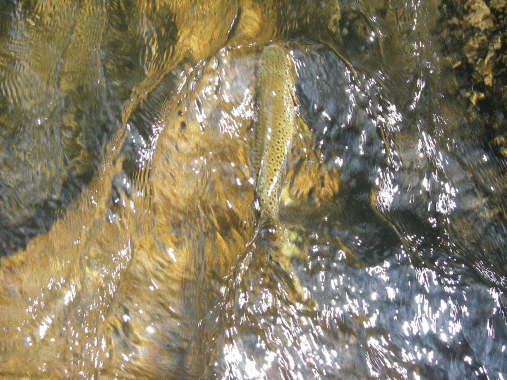 My best was a chunky
eighteen. Sue released a couple of sixteens. Most were in the nine
to twelve inch range. All were very wild fish.
My best was a chunky
eighteen. Sue released a couple of sixteens. Most were in the nine
to twelve inch range. All were very wild fish.
Don't know how many we touched and forceps removed today, but it was a bunch. The bulk of the fish we never had to release as they were strong enough to leap and throw the hooks before that became a necessity.
This river at a flow rate of maybe 100-125 c.f.s. is still tough to wade in places. We could only move back and forth in certain spots.
Anyone who goes here needs to understand that the better fishing is in the more difficult pocket water.
Fly patterns. Not a problem. Whatever works in any back country stream works here. Humpies, Royal Coachmen, stimulators, any kind of attractor is successful.
Sue and I used diametrically opposite approaches today. She probably had more strikes, but I hooked more fish. She used a double dry fly rig of a Royal Coachman and either a grasshopper or humpie. I stuck with a rubber legged WRS - dark color was better - and kept with a single dry fly.
Nymphs did not work for us - not even on the bigger fish. Go figure.
We used 5X tippet in shallower freestone water and shifted to 3X in the faster pocket water. The stronger makes extractions from overhanging willows and alders a bit easier. Expect to lose lots of flies and replace many tippets.
The photos that follow will in a modest way somewhat explain that situation but will not show the bruises we suffered trying to move along the banks in the tougher stretches. This is hard work fishing, but worth it - if you're healthy and athletic. If not, don't try this.
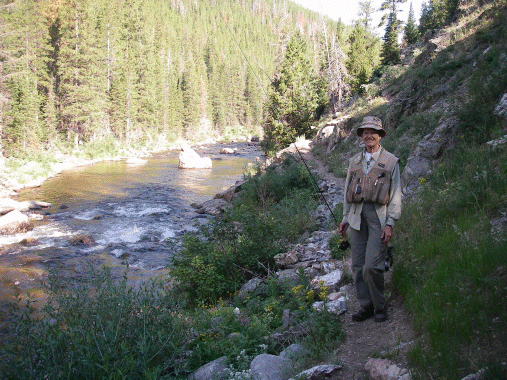
On the trail downstream from the trailhead. Nice walking here - not so nice on the return.
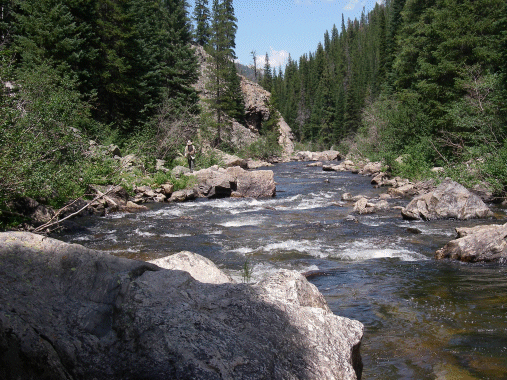
Scrambling over and around the rocks and willows in the pocket water.
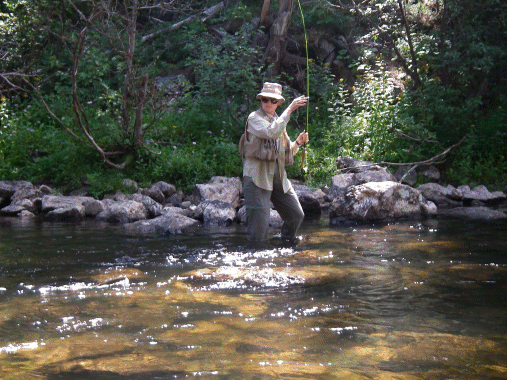
Fish on! A fat sixteen inch wild brown about to be released.
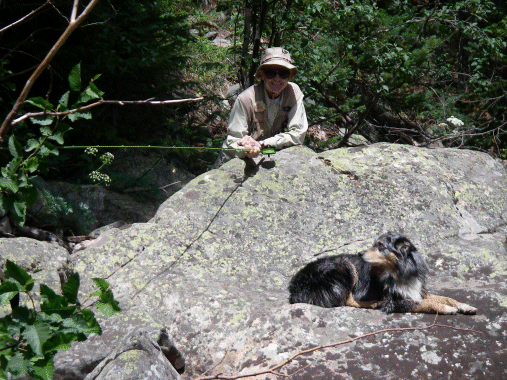
Tired, but happy doggy & wife on the trudge back up through the pocket water.
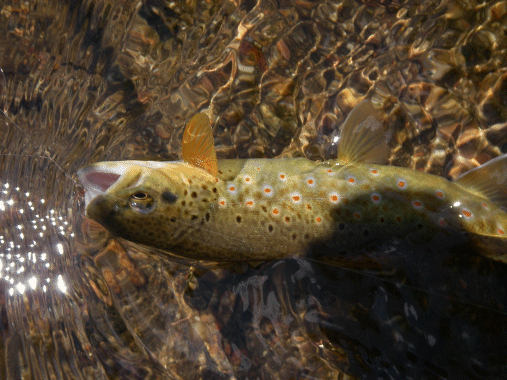
One last "native" brown for the trip.
It was a fun trip - not for the fainthearted or weak of limb. We'll come back here probably once a year until the place becomes overrun and over fished as eventually happens to most other fine places. There are a couple more interesting creeks in this part of the state we'll explore next year.
For now, and for next week, it looks like we're off on that loop trip through Taylor Park, the river of that name, the Gunnison, East River, and finally Anthracite Creek for three days starting, hopefully, on Monday. Life's short. Play hard.
7/25-27:
This week's adventure is a trip we try to do at least twice a year. It's a loop down through the Arkansas valley over a pass to the Taylor River/Gunnison valley and then back through the Roaring Fork valley. Lots of valleys in a short period of time. Early in the season (as in now) the rivers we fish tend to have stronger hatches, somewhat swifter currents, but more competition from summer visitors to Colorado. So it's a mixed blessing.
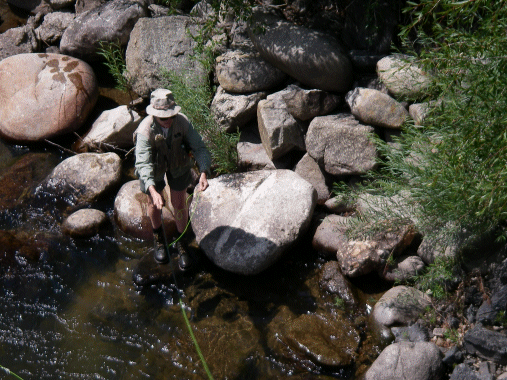 We drove the long
road to Buena Vista Monday morning and arrived in that town an hour or so before
we needed to fuel up (stuff ourselves with the great burgers from the Dairy
Delite), and we headed directly to River Park to do our standard hike down, then
fish up on the stretch of the Arkansas just below the bridge across the river at
that point.
We drove the long
road to Buena Vista Monday morning and arrived in that town an hour or so before
we needed to fuel up (stuff ourselves with the great burgers from the Dairy
Delite), and we headed directly to River Park to do our standard hike down, then
fish up on the stretch of the Arkansas just below the bridge across the river at
that point.
Flow rates are still quite high as we anticipated, primarily to accommodate the massive numbers of rafts that float from Pine Creek through Royal Gorge this time of year.
Caddis really weren't present in great numbers in the brush by the banks - but the fish knew they either were in the area or had been in the recent past.
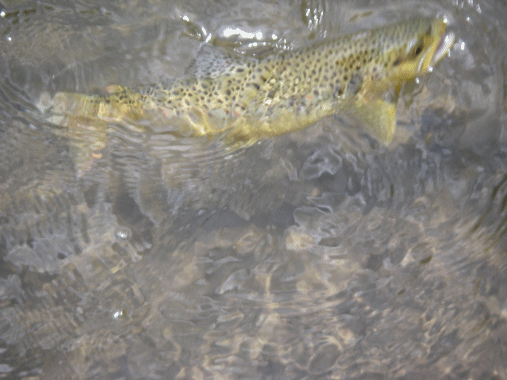
A rig up of a leading #18 WRS trailed by an antenna pupa brought nice numbers of fish to the flies, although these browns were much pickier than were their cousins the prior week on the Encampment.
It took a handful of rapier like strikes to convince me that I needed to be much more attentive.
As we'd only an hour or so to enjoy this water, we fished a half mile quite rapidly and had decent success. None of the slobs were large - none over twelve inches, but all were fun.
Sue released a relatively rare twelve inch cutthroat as well, and I a slightly smaller rainbow.
After stuffing our gullets with the local burger and fries we headed up and over Cottonwood Pass, not attempting any casting on the stream of that name. While there's plenty of public access on this creek, it's very much grown over by willows, flattened in many places by beaver ponds, and to my personal way of thinking, too much work for too little reward.
Getting down to Taylor Reservoir and doing the drive up the inlet stream was very disappointing. Virtually every one of our choice pulloff areas were occupied by the unpleasant OHV groups that - again, just in my opinion - plague this and many other high mountain valleys here in the state.
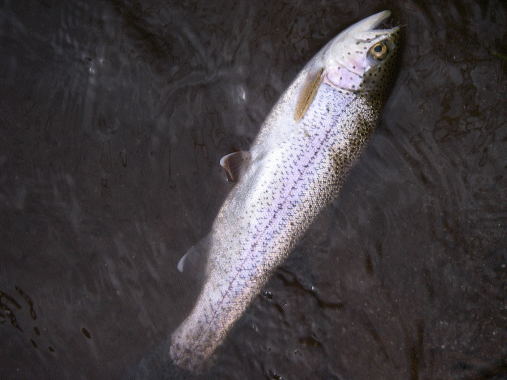 After driving a good
half dozen miles up the river, we gave up, headed back towards the reservoir and
stopped for a half hour around the campground area which has always been decent
fishing.
After driving a good
half dozen miles up the river, we gave up, headed back towards the reservoir and
stopped for a half hour around the campground area which has always been decent
fishing.
Despite the strong downstream winds caused by thunderstorms in the area, today was no exception. The fish weren't large, but the little rainbows and the occasional brown that took either the rubber legged WRS or trailing pupa, were decent fighters and it was a nice break in the late afternoon.
Stopped again driving by the lake where a tiny creek enters that body of water which has sometimes given up good rainbows to mayflies, but today it was a zero.
Below the dam I spent a good hour trying to entice any of the overworked, oversized fish that live in the tailwater to my #22 comparadun and had no success - one quickly missed strike was the only reward.
We wrote off the rest of the day and the upper part of the Taylor due to lots of rain, persistent thunderstorms and camped at our favorite spot above the Almont Triangle. Free is good where camping is concerned.
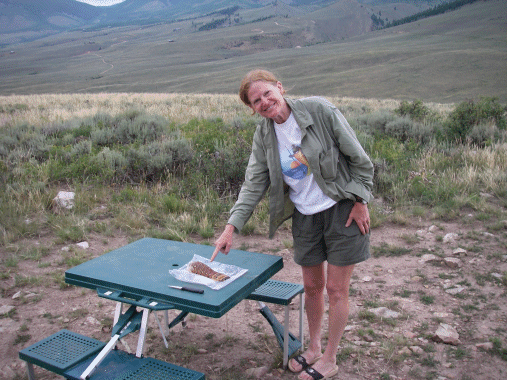
Even more good was the one pound lobster tail we converted into delicious lobster rolls.
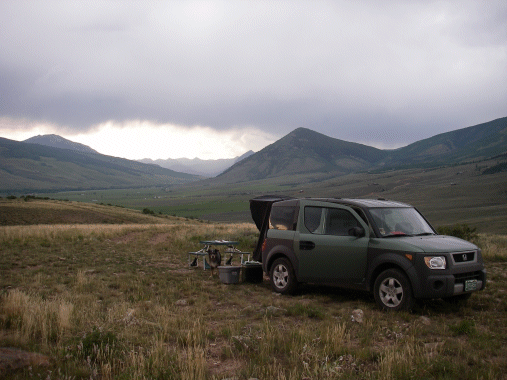
And the view towards Crested Butte from up high on this plateau is always a treat.
Next morning we passed on fishing the lower Taylor due to the cold air temperatures and leftover rain from the previous night's storms. Drove into Gunnison and enjoyed another nice breakfast at the Quarter Circle. I'm always amazed when the plate of huevos arrives, I'm able to consume it all, and still come away not completely full.
Our next opportunity was supposed to be on the Gunnison just above Blue Mesa Reservoir. Unfortunately Blue Mesa now extends so far up the river that three of my favorite spots are completely under many feet of lake water. We messed around looking for some kind of decent stream access and finally gave up, leaving the river, driving back through Gunnison, and heading for the next place on our fishing (shopping) list - the Taylor River.
I'll admit the Taylor has never been a favorite of mine. The tailwater is fun because it's so technical, but the lower river runs as swift and rough as the North Umpqua in Oregon, and I've never really figured it out.
Today was a bit better. I experimented at a couple of the public pulloffs on the lower river just above Almont and found out that a black streamer was the answer compared to throwing anything on the surface. Armed with that knowledge, both Sue and I found lots of good success up the river. Pretty much every decent holding spot gave up a nice fish or several to us.

Most were rainbows, but Sue released a beautiful sixteen inch cut from beside this big rock in midstream.
With a couple of satisfied smiles on our faces we then crossed over the Triangle to the East River.
Got to Roaring Judy, grabbed a sandwich and began our research on this nice stream. It's a bit high and a somewhat difficult to wade right now, but we both had very good success wherever we waded. Suspect we spent a good three hours on various parts of this nice public water.
It was interesting that both of our rigs brought success from different angles. Sue settled on a leading WRS trailed probably five feet by a #18 red copper john. Almost all her strikes came from the nymph. I shifted things around a bit and finally settled on a #18 gray bodied WRS and trailing antenna pupa and got almost all my strikes on the dry. Will admit I don't understand the logic behind the fish's choices through all of this. Most of our fish were browns. Each of us missed a couple of really nice sized fish in the 14-16 inch range, and eventually I did land a fourteen incher.
We'll be back to this river in the fall when the summer crowds have gone home - and the kokanee are running to the hatchery. Neither of us have caught one of those funny little salmon, but we'll try again this year.
As we were running ahead of our planned schedule, we got to Crested Butte too early for dinner. Even trying to do some shopping for an hour didn't kill enough time to justify hanging around to try one of the high end restaurants in that funky little mountain town, so we kept on going up and over Kebler Pass all the way down Anthracite Creek (running turbid) and camped for the night just below the forks on the North Fork of the Gunnison.
Rained cats & dogs during the night. North Fork was ugly brown in the morning. Gave up thoughts of fishing there. Drove up & over McClure Pass, down the Crystal, had a light camping breakfast in Redstone and then fished that water for a while. It was decent, if not great. The Crystal's still on the high side too and moderately off color as well.
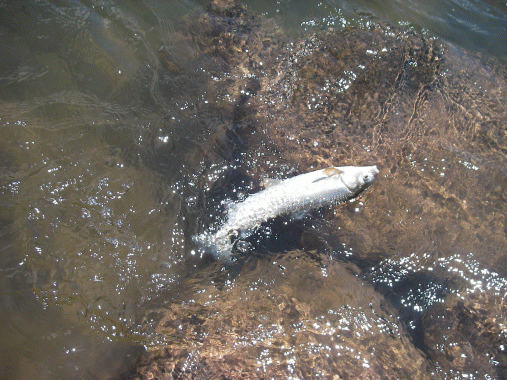
Released a few smallish rainbows, whitefish, and a couple of browns in two sections we fished.
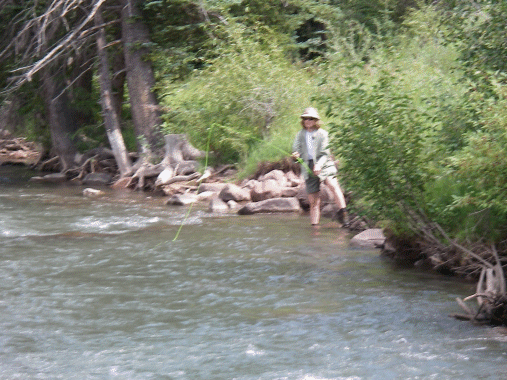
The bad thing as well as the good thing about the Crystal right now is that it's running pretty high for this time of year, and the flow will be optimum a bit later in the summer - hopefully on our next trip here.
On to Glenwood for lunch. Lots of Roaring Fork options were available, the day a being midweek one. Sue suggested the airport section and I agreed. It turned out to be something of a mistake over the noon hour. All the river guides had pulled off in that mile long stretch for their lunch, so we could not access the best shallow water section of the stream. Sue stuck with a dry/nymph setup for a while until it proved useless in this swift, deep bank water.
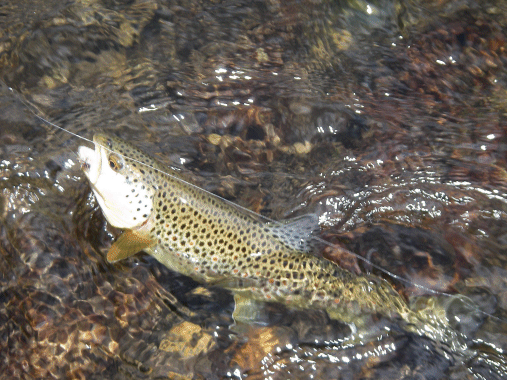 I tried the same
approach for a while but pretty quickly switched off to a deep running leading
stone and trailing antenna pupa. Weighted even further with a # 6 split
shot, this rig really did the job.
I tried the same
approach for a while but pretty quickly switched off to a deep running leading
stone and trailing antenna pupa. Weighted even further with a # 6 split
shot, this rig really did the job.
Probably the best fishing I've ever had in this piece of water.
Lots of very large whitefish, several browns over twelve inches, and three really big fish, one of which was a rainbow of over two feet in length that I saw, but shortly lost when he disappeared across the stream. It was an amazingly strong fish. At first I thought I was snagged on a midstream rock, walked up the river to dislodge it, and then it began to move.
Played it for a couple of minutes when it turned at me near the surface, said sayonara, and powered away as though I was not even attached to it.
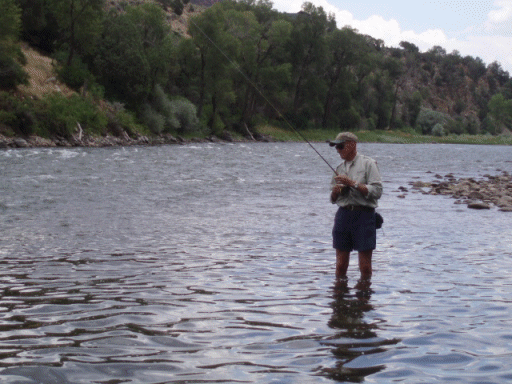
A nice trip again. Not perfect, though few of these trips ever are - or probably ever should be. We don't want to get too spoiled or jaded.
Next week we may head back to our "favorite" Colorado river - assuming Sue has some time off from work.
Last Logbook Entry � for previous days.
7/31: Last day of a full month of fishing for us in July. I remain obsessed about catching some pike at Williams Fork Reservoir and am nonplussed as to why that hasn't happened yet this year. The only thing I've changed about the approach to those fish near the inlet area is to use a lightweight steel leader, but surely that can't be objectionable to these aggressive fish - or could it really be a problem? They can't possibly be that visual. I hope.
Anyway the drought continued again late this morning when I walked the entire shoreline and came up completely blank again. Had thought about trying the outlet stream from Shadow Mountain all the way to Granby, but with clouds building on the horizon, it looked like this was going to be a short day on the water due to heavy thunderstorms in the area.
So instead I drove to the Williams Fork tailwater trailhead and did the two mile or so walk across the SWA to the upper part of that stream. It's running a bit high right now and the wading was very iffy. I managed to get across OK but had some concerns about getting back at the end of the trip. Even moving along the banks can be tough as the water's well up into the grasses and lots of deep holes appear where they normally wouldn't exist.
Had poor success for the first half mile I struggled upstream. Missed a couple of good strikes and changed the rig from a #18 gray bodied WRS to a #16 rubber leg model. Trailed it with one of our hybrid pupas. Finally up near the dam started getting some hookups. Fish were fairly evenly split between the surface fly and the nymph. Interestingly both of the larger trout that I played today (16-17 inches) took the pupa on the swing. Rest of the fish seemed to take it normally. Don't know why the larger, supposedly smarter of those browns chose to strike strangely at what should have appeared to be an unnaturally drifting bug.
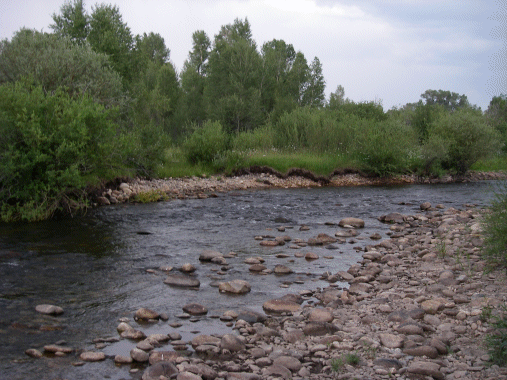 Did the same hike
back to the car around 1:30, had a quick lunch and drove back to the inlet
stream above the reservoir.
Did the same hike
back to the car around 1:30, had a quick lunch and drove back to the inlet
stream above the reservoir.
As the clouds were definitely thickening, I had time for only a few casts in a couple of the lowest pools on the inlet and they produced fish (albeit very small ones) almost every time the fly hit the water.
Pretty evenly split between browns and rainbows, the fish were all in a six to ten inch range. Had the rain not begun in earnest shortly thereafter, I suspect the pools further upstream might have been outstanding.
Later this week we hope to spend a couple of days on our "favorite" water up in the northwestern part of the state. Then on Friday, as I have to do some data entry in the town of Eagle, I'll try that river for the first time this season.
Home, Main Fishing Page, , Eagle River Access, Local Ten Commandments, Successful Fly Patterns